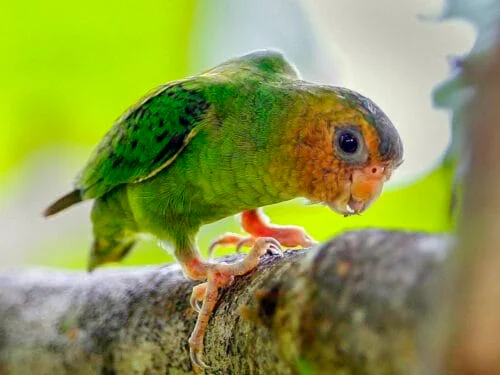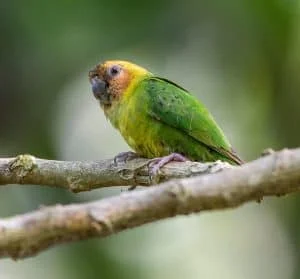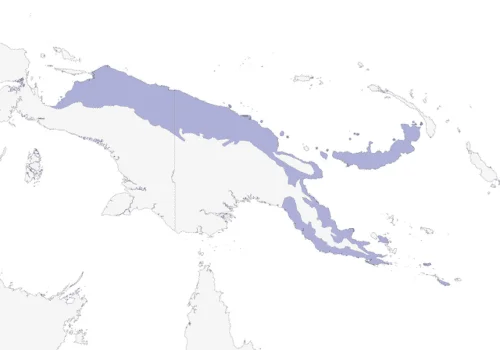The world’s smallest parrot is the Buff-faced Pygmy Parrot (Micropsitta pusio), a tiny, colorful bird that charms enthusiasts with its diminutive size and enchanting behavior.
Welcome back to our nature blog, where we celebrate the diverse and fascinating world of wildlife with an informational yet light-hearted approach. In this article, we’re introducing you to the world’s smallest parrot, the Buff-faced Pygmy Parrot!
These pint-sized parrots may be tiny, but they are full of character and charm. Join us on an exciting journey as we discover more about these delightful little birds and their captivating lives in the wild.

The Buff-faced Pygmy Parrot (Micropsitta pusio) is the smallest parrot species in the world, with a length of just 8-10 cm and a weight of around 11-12 grams. These tiny birds belong to the Micropsitta genus, which comprises six species of pygmy parrots, all native to the rainforests of Papua New Guinea and the Solomon Islands.
Despite their small size, Buff-faced Pygmy Parrots boast a stunning array of colors, making them a visual delight for birdwatchers and nature enthusiasts alike.
Appearance
The Buff-faced Pygmy Parrot’s vibrant plumage is truly a sight to behold. Both males and females have a predominantly green body, with the males featuring a stunning blue streak above the eye and a blue rump.
Females, on the other hand, have a more subdued coloration with a greenish-blue rump. The eponymous buff-colored face is present in both sexes, giving them their charming name. These bright colors not only add to their visual appeal but also help them blend seamlessly into their lush rainforest habitat.

Habitat and Distribution: Where to Find the World’s Smallest Parrot
If you’re an avid birdwatcher or simply curious about the world’s smallest parrot, you might be wondering where you can catch a glimpse of these charming birds. The Buff-faced Pygmy Parrot can be found in the rainforests of Papua New Guinea and the Solomon Islands.
To increase your chances of spotting these elusive birds, consider visiting a national park, wildlife reserve, or protected area where their populations are known to reside.
Keep an ear out for their high-pitched calls, which can help you locate them in the treetops.
Buff-faced Pygmy Parrots are highly adapted to their rainforest environment, spending most of their lives in the dense foliage of the treetops. They are social birds, typically living in small groups or family units.
These tiny parrots are known for their energetic and agile behavior, often seen hopping and climbing along tree branches in search of food. Their zygodactyl feet, with two toes facing forward and two facing backward, enable them to easily navigate their arboreal world.

Diet and Hunting: The Smallest Parrot in the World
The diet of the Buff-faced Pygmy Parrot primarily consists of lichen, tree bark, and various fungi, making them one of the few parrot species that specialize in such fare.
They have a unique feeding technique that involves clinging to tree trunks and branches while using their sharp, curved beaks to scrape off lichen and fungi. This specialized diet not only sets them apart from other parrot species but also plays an important role in maintaining the health of their rainforest ecosystem.
Love in Small Packages: Mating and Reproduction
Buff-faced Pygmy Parrots have a fascinating approach to nesting. Instead of constructing their own nests, they take advantage of the work of other animals. These tiny parrots often seek out abandoned termite nests or small cavities in trees that have been excavated by insects.
They then modify the cavity to suit their needs, creating a cozy, well-insulated space to lay their eggs and raise their young. Both parents take part in incubating the eggs and caring for the chicks, showcasing their strong pair bond and cooperative nature.
Conservation Status
While the Buff-faced Pygmy Parrot is not currently considered endangered, it does face threats that could impact its long-term survival. Habitat loss and degradation due to logging, agriculture, and mining activities pose significant challenges for these tiny birds.
Climate change may also have negative effects on their rainforest habitats.
Conservation efforts are crucial to ensure the continued survival of the Buff-faced Pygmy Parrot and the preservation of the delicate ecosystems they inhabit. These efforts include habitat protection, monitoring populations, and raising awareness about the importance of preserving rainforests and their unique biodiversity.
Fun Fact
Despite their tiny size, Buff-faced Pygmy Parrots are known for their remarkable ability to mimic sounds from their environment.
While they might not be as skilled at mimicking human speech as their larger parrot cousins, they can still imitate a variety of natural sounds, such as the calls of other birds or even insects.
This intriguing ability not only adds to their charm but also serves as a useful survival strategy, allowing them to blend in seamlessly with their rainforest surroundings and potentially deter predators.
Conclusion
The world’s smallest parrot, the Buff-faced Pygmy Parrot, is a fascinating and charming member of the avian world. With their stunning colors, unique feeding habits, and captivating behavior, these little birds never cease to amaze and delight nature lovers and birdwatchers.
By continuing to learn about and protect the Buff-faced Pygmy Parrot, we can help ensure their survival and the health of the rainforest ecosystems they call home.
So, the next time you find yourself exploring the lush rainforests of Papua New Guinea or the Solomon Islands, keep an eye out for these tiny feathered wonders – you might just be fortunate enough to encounter the enchanting world of the Buff-faced Pygmy Parrot!
